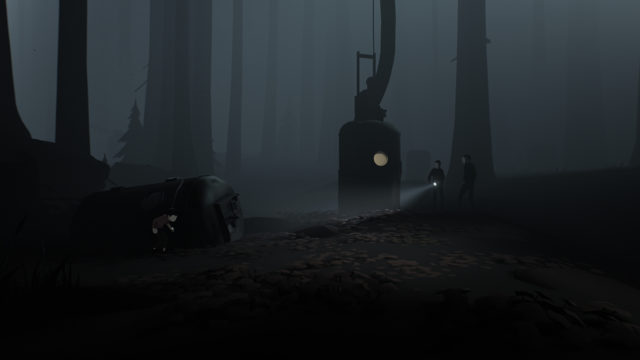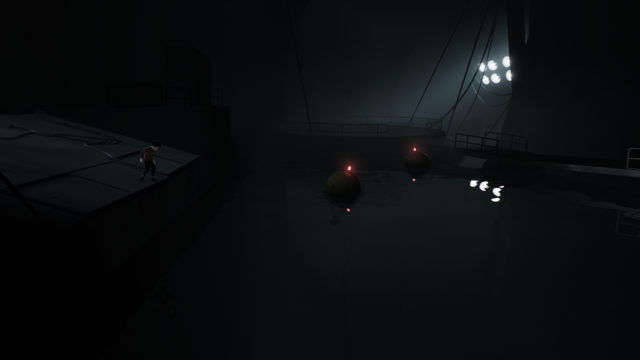Artistically ambitious; thick with atmosphere; mostly compelling and mysterious wordless narrative; many solid puzzles.
Some redundant puzzles hurt the pacing; ending doesn't match the build-up; short play-time could turn some off.
Playdead originally released Inside two years ago to near universal acclaim. The success of their first game, Limbo, set expectations high, and the developer was smart enough to know what to change and what to stay true to. Like its predecessor, Inside is a puzzle driven platformer featuring an almost oppressively dour atmosphere and simple yet solid gameplay mechanics. The art style saw significant changes, though not for the worse. Now, Inside has finally found its way to Switch, a system that is pretty much perfect for this type of game. However, this ideal marriage between platform and game doesn’t change the fact that Inside is actually rather overrated.
Explaining Inside is tough, because it is far too easy to share too much information as the game thrives on the reveal of its setting and mechanics. To put it succinctly, you play as an unnamed boy pressing onward through a somber and occasionally horrific world toward an end you are unlikely to fully understand even after finishing the game. The journey starts in a foggy forest where a group of men and their dogs appear to be hunting the boy, but you eventually move onward into farms littered with pig corpses and dystopian cityscapes where a seemingly dominated populace march to the whims of an unknown oppressor. More areas are eventually revealed and they are all equally bleak and beautiful, in a ruinous sort of way. The camerawork helps build this sense of mood, because even though the game plays as a 2D platformer, everything is rendered in 3D and the camera uses this to great effect as it establishes angles and lighting that would make any Hollywood cinematographer jealous. In short, the game’s visuals are gorgeous and legitimately artistic.
The accompanying audio is also effective, though not to the same degree. The sound effects are almost spot-on, though there are some moments near the end where I feel some of the audio design lets the game down and comes across as almost comedic in areas where I think it’s supposed to be more serious. The music favors a minimalist style and it fits the game’s aesthetic, though it is so rarely used that it sometimes feels a little jarring when it finally does come in. I kind of wish they had decided to use the music more frequently or perhaps completely do without it, but these complaints are ultimately minuscule compared to how effective the overall sound design is.

Once you actually start playing Inside, you quickly realize it is actually a rather simple game as you generally move to the right and interact with the world with a mere two buttons. One button is for jumping and clambering over obstacles; mechanics that are never used for anything particularly challenging. Yes, there’s a good chance you’ll die from time to time, but these deaths come not as a result of tough level design, but rather as a product of the game’s physics. Here, Inside aims for a certain sense of realism, something that often results in a cumbersome sense of momentum that is more likely to inspire frustration than enjoyment. This translates to some cheap deaths, but is rarely a significant concern thanks to frequent, generous checkpoints.
Your second button is a general interaction button used for flipping switches, grabbing onto objects and all the other little tasks needed for solving the game’s puzzles. Overall, these puzzles are quite good and are well balanced considering the fact they primarily serve the purpose of adding some variety to the experience rather than posing a serious threat to your progress. Playdead wants you to experience Inside, and they obviously didn’t want the puzzles to be an insurmountable roadblock. Some of them, such as block pushing puzzles, are obviously quite “gamey,” but many others are very well integrated into the world and unfolding narrative. To say any more would be to spoil too much.
Unfortunately, while Inside seems to be doing everything right throughout much of its runtime, the game ultimately feels too long… which is odd to say about a game that can easily be completed in well under three hours. There is a stretch in the later half of Inside that calls to mind the immortal words uttered in a now infamous IGN review: “Too much water.” There are not one, but two areas within the game that prominently feature water and it pops up in several others and it utterly destroys the pacing. The first water focused area introduces an enjoyable new mechanic but the second is so slow paced and repetitive that the water might as well be molasses. It repeats the same basic gameplay idea several times with no meaningful variation and its redundancy kills what at first was relatively tense. In fact, the general issue of puzzle redundancy pops up throughout the game to a lesser extent, but this one, waterlogged example is much more than a minor distraction.

And then there’s the end. It’s far from bad but it doesn’t quite match the level of build-up established earlier on. At least it’s definitely interesting and manages to introduce a new twist to the gameplay before closing out the game, so it deserves at least some praise for that. But once again, saying more would be a disservice for those wanting to see it for themselves.
Inside is a good game bordering on great. Playdead obviously had an ambitious vision they were trying to realize with the game, but a few slip-ups were made along the way that make it fall short of the “all-time great” status they were no doubt aiming for. Interestingly enough, most of these issues come down to small gameplay mistakes that are magnified by what is an otherwise laser-focused experience. While I wouldn’t argue that the game would ultimately work best as a walking simulator, a term I use with intended derision, it probably would have been better suited with less traditional “gameplay.” These issues aside, Inside remains a worthwhile experience for those looking for something very unique that doesn’t define its value simply by how long it will keep you playing. The game is short and let down by some noticeable issues, but beyond that, it’s a beautifully strange experience many will at least find interesting, with a fair few probably considering it brilliant.
Nintendojo was provided a copy of this game for review by a third party, though that does not affect our recommendation. For every review, Nintendojo uses a standard criteria.




 ShareThis
ShareThis





